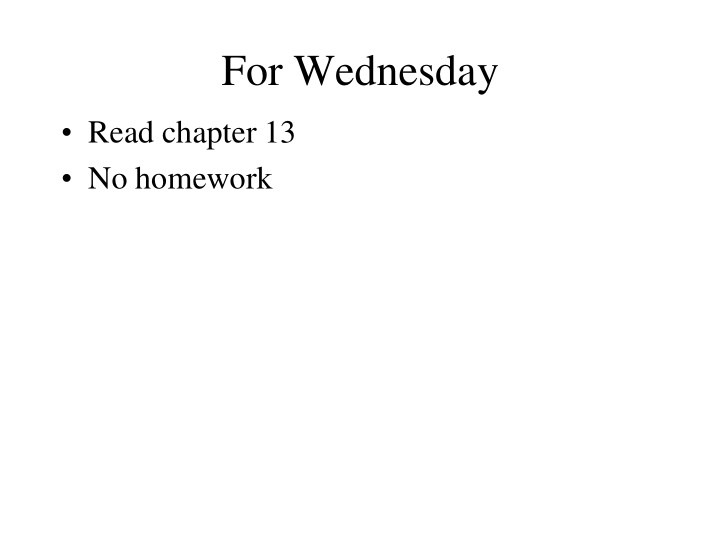



For Wednesday • Read chapter 13 • No homework
Program 2 • Any questions?
What does ISA mean?
Categories • Membership • Subset or subclass • Disjoint categories • Exhaustive Decomposition • Partitions of categories
Other Issues • Physical composition • Measurement • Individuation – Count nouns vs. mass nouns – Intrinsic properties vs. extrinsic properties
Question 3 • How do we talk about changes?
• When an agent performs actions, the situation the agent is in changes. • Sometimes need to reason about the situation. • Planning
Axioms for Actions • Can we do the action? • What changes? • What stays the same? – The frame problem
An Answer • Identify changes to the situation and assume everything else remains the same. • Effect axioms become lists of changes.
More than One Agent • Keep track of events rather than situations. • Have to deal with intervals of time. • Have to deal with processes . How do processes differ from discrete events ? • Objects and their relation to events.
Question 4 • How do we talk about belief?
Reification • Turning propositions into objects. • Why would we want (need?) to do this?
Consider the following: • Jack thinks that the President is still George Bush. • When I was in Washington, D.C. last month, I got to meet the President.
• This is the issue of referential transparency vs. referential opaqueness .
• Special rules for handling belief: – If I believe something, I believe that I believe it. – Need to still provide a way to indicate that two names refer to the same thing.
Knowledge and Belief • How are they related? • Knowing whether something is true • Knowing what
And Besides Logic? • Semantic networks • Frames
Semantic Networks • Use graphs to represent concepts and the relations between them. • Simplest networks are ISA hierarchies • Must be careful to make a type/token distinction: Garfield isa Cat Cat(Garfield) " x (Cat (x) Feline(x)) Cat isa Feline • Restricted shorthand for a logical representation.
Semantic Nets/Frames • Labeled links can represent arbitrary relations between objects and/or concepts. • Nodes with links can also be viewed as frames with slots that point to other objects and/or concepts.
First Order Representation Rel(Alive,Animals,T) Rel(Flies,Penguins,F) Rel(Flies,Animals,F) Rel(Legs,Bats,2) Birds Animals Rel(Flies,Bats,T) Mammals Animals Opus Penguins Bill Cats Rel(Flies,Birds,T) Pat Bats Rel(Legs,Birds,2) Rel(Legs,Mammals,4) Name(Opus,"Opus") Penguins Birds Name(Bill,"Bill") Cats Mammals Friend(Opus,Bill) Bats Mammals Friend(Bill,Opus) Name(Pat,"Pat")
Inheritance • Inheritance is a specific type of inference that allows properties of objects to be inferred from properties of categories to which the object belongs. – Is Bill alive? – Yes, since Bill is a cat, cats are mammals, mammals are animals, and animals are alive. • Such inference can be performed by a simple graph traversal algorithm and implemented very efficiently. • However, it is basically a form of logical inference " x (Cat(x) Mammal(x)) " x (Mammal(x) Animal(x)) " x (Animal(x) Alive(x)) Cat(Bill) |- Alive(Bill)
Backward or Forward • Can work either way • Either can be inefficient • Usually depends on branching factors
Semantic of Links • Must be careful to distinguish different types of links. • Links between tokens and tokens are different than links between types and types and links between tokens and types.
Link Types Link Type Semantics Example A B Cats Mammals A subset B A B Bill Cats A member B A R B Bill Age 12 R(A,B) " x, x A A R B Birds Legs 2 R(x,B) " x y, x A y A R B Birds Parent Birds B R(x,y)
Inheritance with Exceptions • Information specified for a type gives the default value for a relation, but this may be over-ridden by a more specific type. – Tweety is a bird. Does Tweety fly? Birds fly. Yes. – Opus is a penguin. Does Opus fly? Penguin's don't fly. No.
Multiple Inheritance • If hierarchy is not a tree but a directed acyclic graph (DAG) then different inheritance paths may result in different defaults being inherited. • Nixon Diamond
Nonmonotonicity • In normal monotonic logic, adding more sentences to a KB only entails more conclusions. if KB |- P then KB {S} |- P • Inheritance with exceptions is not monotonic (it is nonmonotonic) – Bird(Opus) – Fly(Opus)? yes – Penguin(Opus) – Fly(Opus)? no
• Nonmonotonic logics attempt to formalize default reasoning by allow default rules of the form: – If P and concluding Q is consistent, then conclude Q. – If Bird(X) then if consistent Fly(x)
Defaults with Negation as Failure • Prolog negation as failure can be used to implement default inference. fly(X) :- bird(X), not(ab(X)). ab(X) :- penguin(X). ab(X) :- ostrich(X). bird(opus). ? fly(opus). Yes penguin(opus). ? fly(opus). No
Recommend
More recommend